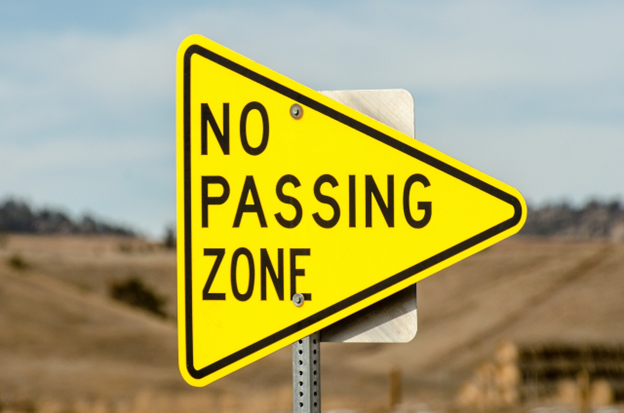Ever wonder why road signs vary so much in size, color, and shape? There’s a practical reason for it. Each element of a road sign’s design is carefully planned to grab drivers’ attention and convey important information quickly.
One of the less common but important signs you might encounter is the pennant-shaped sign. Its unique triangular shape is easily recognizable and plays a crucial role in keeping roads safe.
In this blog, we will explore what makes this sign essential and how it contributes to smooth and secure traffic flow.
What are Pennant-Shaped Signs?
Pennant road signs are unique and triangular in shape. They convey one important message on the roads: no-passing zones.
In most no-passing zones, you’ll typically see a pennant sign paired with a solid yellow line in your lane. The pennant-shaped sign is strategically placed on the left side of the road, often paired with the white and black “Do not pass” sign on the right.
This combination works perfectly to convey the message: stay in your lane and don’t overtake.
The Meaning Behind No-Passing Zones
No-passing zones are areas where it’s unsafe to overtake another vehicle. The pennant-shaped sign indicates that on a two-lane road, drivers should not attempt to pass the vehicle ahead until the zone where these signs are posted has ended.
Yet, there are always a couple of exceptions to the rule. In most places, you’re allowed to cross that center line in a no-passing zone for a few specific reasons:
- If something is blocking your path on the right side of the road. If there’s a parked car or fallen tree branches, and it’s safe to move around, you can briefly cross into the opposite lane.
- When approaching a bicyclist or pedestrian on the road, it’s permitted—and often safer—to move into the opposite lane to give them more space, provided the other lane is clear of oncoming traffic.
Where are Pennant-Shaped Signs Typically Placed?
A pennant-shaped road sign is usually posted in areas where passing other vehicles could be dangerous due to restricted visibility or road configurations.
You’ll often find these signs on two-lane roads with curves, hills, or other features that limit a driver’s ability to see oncoming traffic clearly and from a sufficient distance.
These roadway signs are placed on the left, facing the driver to clarify that the zone ahead is a no-passing zone and that overtaking other vehicles is prohibited.
The positioning and distinct shape of the pennant sign ensure that drivers are aware of their speed limits and notice this important safety regulation as they approach.
How Many Types of Pennant Signs Exist?
The design of road signs, including their shapes and colors, are standardized by the federal government in the Manual on Uniform Traffic Control Devices for Streets and Highways.
In the United States, there is only one type of pennant-shaped sign, which is exclusively used for marking no-passing zones. Its consistent use helps drivers quickly recognize and understand that overtaking another vehicle from an adjacent lane could be dangerous.
Other Road Sign Shapes and Their Meanings
Road signs come in various shapes, each with a specific meaning that helps drivers understand the information being conveyed at a glance. Here’s a quick overview of some common road sign shapes and what they typically mean:
- Octagon: Stop signs that command drivers to halt completely at intersections.
- Triangle: Yield signs, marked by inverted triangles, instruct drivers to slow and prepare to stop.
- Rectangle: Vertical rectangles regulate (e.g., speed limits, no parking), while horizontal rectangles guide (e.g., directions, distances).
- Diamond: Diamond signs warn of potential hazards, route markings, or conditions ahead (sharp turns or school zones.)
- Circle: Circular signs signal upcoming railroad crossings that caution drivers to be ready to stop for train crossing.
- Pentagon: Pentagon signs indicate school zones and crossings, urging drivers to exercise extra caution around children.
- Shield: Shield-shaped signs denote U.S. highways and interstates, which guide drivers along these major routes.
Become a Safer Driver, Learn Crucial Road Signs Today!
Stay sharp on the road! You can check our driving courses to help you refresh your driving knowledge. You may also learn more about safe driving practices, ticket dismissal, and point reduction.
FAQs About Pennant-Shaped Signs
What should I do if I accidentally pass where a pennant-shaped sign is posted?
If you realize you’ve passed in a no-passing zone, safely return to your lane as soon as possible without accelerating excessively. Be more cautious and attentive to road signs to prevent a repeat of the mistake.
Are there different colors or sizes for pennant-shaped road signs?
While the shape remains consistent, the pennant-shaped sign typically features a yellow background with black text or symbols. This color scheme is chosen for its high visibility and effectiveness in capturing the attention of drivers.
Do pennant-shaped signs appear alone?
Usually, pennant-shaped signs are part of a set of warnings. They often appear along with other traffic signs like “Do Not Pass” signs or additional road markings that reinforce the no-passing rule, such as solid yellow lines.

 Live Chat
Live Chat






